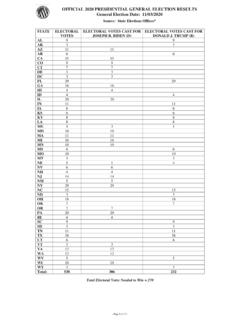Transcription of What is the aurora? - NASA
1 What is the aurora ?Named for the Roman goddess of dawn , the aurora is a mysterious and unpredictable display of light in the night sky. The aurora borealis and aurora australis often called the northern lights and southern lights are common occurrences at high northern and southern latitudes, less frequent at mid-latitudes, and seldom seen near the equator. While usually a milky greenish color, auroras can also show red, blue, violet, pink, and white. These colors appear in a vari-ety of continuously changing shapes.
2 Sometimes the aurora is so dim and scattered as to be mistaken for clouds or the Milky Way; sometimes it is bright enough to read are a spectacular sign that our planet is electrically connected to the Sun. These light shows are provoked by energy from the Sun and fueled by electrically charged particles trapped in Earth s magnetic eld. While beautiful to behold, they can be a nui-sance to those who depend on modern does an aurora look like?Auroras can appear as long, narrow arcs of light, often extending east to west from horizon to horizon.
3 At other times they stretch across the night sky in bands that kink, fold, and swirl, or even ruf e like curtains. They can spread out in multi-colored rays, like vertical shafts of light that stretch far up into space. And sometimes they engulf the sky in a thin cloud or veil. As aurora expert Robert Eather once wrote: Like snow akes, no two are ever quite the same. Dramatically differ-ent auroras can appear in the course of a single night, and all of the forms can vary in intensity. The late evening auroras are usually long diffuse arcs, which slowly evolve into rayed arcs or bands that show increasing activity.
4 As the night progresses, the bands and arcs become rippled and folded, eventually breaking into rays and -- if the viewer is lucky -- a corona. The corona is considered the most spectacular form of a rayed aurora , appearing overhead with all shafts converging to a center point. Patches uffy clouds of light and ickering auroras are generally seen later in the causes the aurora ?The typical aurora is caused by collisions between fast-moving electrons from space with the oxygen and nitrogen in Earth s upper atmosphere.
5 The electrons which come from the Earth s magnetosphere, the region of space controlled by Earth s mag-netic eld transfer their energy to the oxygen and nitrogen atoms and molecules, making them excited . As the gases return to their normal state, they emit photons, small bursts of energy in the form of light. When a large number of electrons come from the magnetosphere to bombard the atmosphere, the oxygen and nitrogen can emit enough light for the eye to detect, giving us beautiful auroral displays.
6 This ghostly light originates at altitudes of 100 to more than 400 km (60 to more than 250 miles). Dual bandsRayed arcCoronaJan CurtisJan CurtisJan CurtisWhy do auroras come in different colors and shapes?The color of the aurora depends on which gas oxygen or nitrogen is being excited by the electrons, and on how excited it becomes. The color also depends upon how fast the electrons are moving, or how much energy they have at the time of their collisions. High energy electrons cause oxygen to emit green light (the most familiar color of the aurora ), while low energy electrons cause a red light.
7 Nitrogen generally gives off a blue light. The blending of these colors can also lead to purples, pinks, and whites. The oxygen and nitrogen also emit ultraviolet light, which can be detected by special cameras on satellites. The different shapes of auroras are a mystery that scientists are still trying to unravel. The shape seems to depend on where in the magnetosphere the electrons originate, what causes them to gain their energy, and why they dive into the can you see an aurora ?Auroras usually occur in ring-shaped areas about 4,000 km (2,500 miles) in diameter around the magnetic poles of the Earth.
8 These rings are known as auroral ovals. The northern oval traces a path across central Alaska and Canada, Greenland, and northern Scandinavia and Russia. In the southern hemisphere, the auroral oval hovers mostly over the oceans circling Antarctica, but it can occasionally reach the far edges of New Zealand, Chile, and Australia. There is a common misconception that auroras can only be seen near the poles of the Earth, but auroras are actually quite rare at the geographic and geomagnetic poles.
9 In fact, if you made an expedition to the north coast of Alaska, you would usually have to look south to see an auroral ovals expand and contract with the level of auroral activity, sometimes extending to lower latitudes to cover much of North America or Europe when the space around Earth is most disturbed. The complete auroral ovals in the north and south are nearly mirror re ections of each other, or conjugate. But it wasn t until the Space Age, when satellites could gather images of the entire Earth, that scientists were able to see the large-scale auroras around both poles at the same can you see an aurora ?
10 Low levels of auroral activity occur day and night, every day, in the northern and southern auroral ovals. Since the aurora is much dimmer than sunlight (a million times), it cannot be seen from the ground in the daytime. The best displays tend to occur in the few hours before pollution caused by city lights makes it dif cult to see auroras except in dark rural areas. Perhaps the best chance to see an aurora is during a high-latitude airplane ight at night. But when a really bright aurora occurs, you can see it from the city and even through thin Alaska and central Canada, the aurora can be a nightly occurrence.




